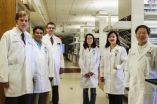(Press-News.org) Ovarian cancer cells hijack surrounding tissues to enhance tumor growth
Tumor growth is dependent on interactions between cancer cells and adjacent normal tissue, or stroma. Stromal cells can stimulate the growth of tumor cells; however it is unclear if tumor cells can influence the stroma. In this issue of the Journal of Clinical Investigation, researchers at MD Anderson Cancer Center report that ovarian cancer cells activate the HOXA9 gene to compel stromal cells to create an environment that supports tumor growth.
Honami Naora and colleagues found that expression of HOXA9 was correlated with poor outcomes in cancer patients and in mice with ovarian tumors. The expression of HOXA9 in ovarian cancer cells caused the cells to produce a protein called TGF-β. TGF-β then induced the surrounding non-cancerous cells to create an environment that supports the tumor. Blocking TGF-β expression in the ovarian cancer cells significantly reduced tumor growth. These findings raise the possibility that drugs targeting TGF-β could be used to treat ovarian cancer.
TITLE:
HOXA9 promotes ovarian cancer growth by stimulating cancer-associated fibroblasts
AUTHOR CONTACT:
Honami Naora
University of Texas MD Anderson Cancer Center, Houston, TX, USA
Phone: 713-563-4222; E-mail: hnaora@mdanderson.org
View this article at: http://www.jci.org/articles/view/62229?key=b6ff63068b5ca3f2ed18
A one-two punch by the immune system knocks out cancer cells
An emerging class of therapies called "checkpoint blockade" enhance the immune system's ability to attack cancer cells by interfering with the immunological checkpoints that slow or stop immune cell activation and proliferation in the presence of tumors. Cytotoxic T lymophocyte antigen-A (CTLA) receptor is a protein that acts like an "off switch" on certain immune cells. Antibodies targeting CTLA can keep the protein from turning the immune cells off and allow them to attach tumor cells.
In this issue of the Journal of Clinical Investigation, Sandra Demaria and her colleagues at New York University identified factors that determine the effectiveness of anti-CTLA therapy by tracking the activity of immune cells in a mouse model of breast cancer. In this model anti-CTLA therapy alone was ineffective. When given in combination with radiation treatment, however, tumor growth and mestastases was significantly reduced. The researchers found that the radiation therapy caused the cancer cells to release a protein, NKG2D, which activates the immune cells and attracts them to the tumor. These findings will be critical in developing improved treatment regimens utilizing CTLA antibodies.
TITLE:
Suppressing T cell motility induced by anti–CTLA-4 monotherapy improves antitumor effects
AUTHOR CONTACT:
Sandra Demaria
New York University School of Medicine, New York, NY, USA
Phone: 212-263-7308; Fax: 212-263-8211; E-mail: Sandra.Demaria@nyumc.org
View this article at: http://www.jci.org/articles/view/61931?key=0cab0ad5379f7dc2a92a
Blocking inflammation reverses early-stage alcoholic liver disease in mice
More than 12000 deaths per year are attributed to alcoholic liver disease (ALD). Early stages of ALD are believed to be reversible, but there is no definitive treatment available. The early stages of ALD are associated with increased activation of inflammatory pathways. In this issue of the Journal of Clinical Investigation, researchers at the University of Massachusetts Medical Center blocked inflammatory molecules to treat an ALD-like disease in mice.
By feeding mice a diet that included alcohol, Gyongyi Szabo and colleagues were able to mimic ALD progression in humans. They found that inflammation stimulated by a protein known as IL-1. Abrogating production of IL-1 or treating mice with drugs that turn-off the IL-1 inflammatory pathway could prevent the development of ALD in mice and could also reverse early-stage ALD. This study suggests that blocking IL-1 may be a new therapeutic approach in the treatment of ALD.
TITLE:
IL-1 receptor antagonist ameliorates inflammasome-dependent alcoholic steatohepatitis in mice
AUTHOR CONTACT:
Gyongyi Szabo
The University of Massachusetts Medical Center, Worcester, MA, USA
Phone: 508-856-5275; E-mail: gyongyi.szabo@umassmed.edu
View this article at: http://www.jci.org/articles/view/60777?key=46fbdb395504028e9190
Ion channel helps clear airway mucus
Allergens, such as dust, pollen, and smoke, trigger airway inflammation, leading to an increase in mucus secretion. The mucus binds up the allergens and, in a process known as mucociliary clearance, ejects the allergens from the airway. Mucus is formed when dehydrated mucin molecules mix with free water in the airway. Mucus production is required to protect the airway, but in certain inflammatory airway diseases, too much mucus is produced, leading to difficulty in breathing. Mucus production is partially controlled by the number of water molecules in the airway. Water is attracted to the airway by ions, such as chloride, which are pumped out of the cells lining the airway through special channels.
In this issue of the Journal of Clinical Investigation, researchers led by Marcus Mall at the University of Heidelberg in Heidelberg, Germany, examined the role of a particular chloride channel, Slc26a9, in airway inflammation in mice. Mall and colleagues found that both wild type mice and mice lacking Slc26a9 had increased mucus production in response to airway inflammation; however, mice lacking the chloride channel developed airway mucus obstruction. Interestingly, a mutation in human SLC26A9 reduces expression of the chloride channel and is associated with asthma. This study suggests that chloride channels may serve as a target for treating airway diseases associated with mucus plugging such as asthma and cystic fibrosis.
TITLE:
SLC26A9-mediated chloride secretion prevents mucus obstruction in airway inflammation
AUTHOR CONTACT:
Marcus Mall
University of Heidelberg, Heidelberg, UNK, DEU
Phone: +49-6221-568840; Fax: +49-6221-568806; E-mail: marcus.mall@med.uni-heidelberg.de
View this article at: http://www.jci.org/articles/view/60429?key=d44353e3ddaf77adb46c
Researchers identify immune system targets associated with skin blistering disease
Pemphigus vulgaris (PV) is an autoimmune disease in which the body's immune system develops antibodies to two of its own proteins, the desmogleins DSG1 and DSG3 that help maintain the integrity of the skin. The immune attack causes painful blisters on the skin and mucus membranes that can lead to infections. Current therapies are geared towards suppressing the entire immune system, but this is problematic as it causes many side effects and leaves the patient vulnerable to infection.
To identify better therapeutic targets, researchers at the Institute for Research in Biomedicine in Bellinzona, Switzerland, identified the portions of DSG1 and DSG3 that are targeted by antibodies. In the study, published this month in the Journal of Clinical Investigation, Antonio Lanzavecchia and colleagues collected immune cells from PV patients and isolated the antibodies to determine which ones were involved in PV. By studying the antibodies, they were able to identify regions of DSG3 that are the primary target of the immune system. These findings could help with new ways to diagnose and treat PV.
TITLE:
Pathogenic pemphigus autoantibodies generated through somatic mutations target the desmoglein-3 cis-adhesive interface
AUTHOR CONTACT:
Antonio Lanzavecchia
Institute for Research in Biomedicine, Bellinzona, , CHE
Phone: +41-91-8200310; Fax: +41-91-8200312; E-mail: lanzavecchia@irb.unisi.ch
View this article at: http://www.jci.org/articles/view/64413?key=a53362606a4eb63142e7
A delicate balance: gut serotonin and bone maintenance
The hormone serotonin is probably best known for its role in the brain; however, it is also made elsewhere in the body where it regulates multiple physiological processes. Serotonin that is made in the gut is reduces the proliferation of bone cells (osteoblasts) and scientists have suggested that blocking gut serotonin might be method for treating osteoporosis. To determine if this is a feasible treatment method, researchers led by Stavroula Kosteni at Columbia University set out to determine exactly how gut serotonin exerts its effects on bone mass.
In a study published in the Journal of Clinical Investigation, Kosteni and colleagues report that the level of gut-made serotonin released into general circulation determines the activity of a protein known as FoxO1. FoxO1 works as a transcription factor, or a protein that controls which genes are expressed. Depending on the level of serotonin, FoxO1 can interact with a protein that promotes bone formation, CREB, or a protein that blocks bone formation, ATF4. Fluctuations in serotonin levels can therefore either promote or block the formation of new bone cells.
TITLE:
FOXO1 orchestrates the bone-suppressing function of gut-derived serotonin
AUTHOR CONTACT:
Stavroula Kousteni
Columbia University, New York, , USA
Phone: 212-851-5223; E-mail: sk2836@columbia.edu
View this article at: http://www.jci.org/articles/view/64906?key=f305fffbaadd1aebaa12
Cancer cells co-opt a stress response protein
Malignant nerve peripheral sheath tumors are a form of cancer in the connective tissue surrounding nerve cells that is driven by the loss of the tumor suppressor gene NF1. Researchers at the Whitehead Institute in Cambridge, MA recently found that loss of NF1 causes an increase in the expression of a protein known as Heat Shock Factor 1 (HSF1), a protein that normal cells use to respond to cellular stress.
In this issue of the Journal of Clinical Investigation, Chengkai Dai, Susan Lindquist, and colleagues at the Jackson Laboratory in Bar Harbor, ME report that the adaptive responses driven by HSF1 drives the development of cancer and tumor development and is required for cancer cell survival. Additionally, they found that loss of HSF1 suppresses tumor formation in mice and that HSF1 is active in patients with NF1-deficient tumors, indicating that HSF1 may be a target for therapeutic intervention.
TITLE:
Loss of tumor suppressor NF1 activates HSF1 to promote carcinogenesis
AUTHOR CONTACT:
Chengkai Dai
The Jackson Laboratory, Bar Harbor, ME, USA
Phone: 207-288-6927; E-mail: Chengkai.Dai@jax.org
View this article at: http://www.jci.org/articles/view/62727?key=47ec58116d34b078983c
Mouse model sheds light on human pituitary disorder
Pituitary hypoplasia, or incomplete growth of the pituitary gland, causes hormone deficiencies in humans. One form is caused by a mutation in the SOX2 gene, resulting in eye abnormalities, short stature, hearing loss, digestive problems, and learning difficulties. SOX2 is broadly involved in embryonic development. To determine exactly how Sox2 influences development of the pituitary gland, researchers at University College London studied the development of mice that lost SOX2 at different points in development.
In a study published in the Journal of Clinical Investigation, Juan Martinez-Barbera and colleagues report that loss of SOX2 results in a loss of neural precursor cells, which are required for the development of the cells that make growth hormones and trigger their release into the blood stream. By determining exactly what goes wrong when SOX2 is missing, these studies provide a better understanding of human pituitary hypoplasia.
TITLE:
SOX2 regulates the hypothalamic-pituitary axis at multiple levels
AUTHOR CONTACT:
Juan Pedro Martinez-Barbera
University College London, London, UNK, GBR
Phone: +44 (0)207 905 2821; E-mail: j.martinez-barbera@ucl.ac.uk
View this article at: http://www.jci.org/articles/view/64311?key=d784ebf649d728b9be37
### END
JCI early table of contents for Sept. 4, 2012
2012-09-04
ELSE PRESS RELEASES FROM THIS DATE:
EARTH: Antarctic trees surprise scientists
2012-09-04
Alexandria, VA – "Warm" and "Antarctica" are not commonly used in the same sentence; however, for scientists, "warm" is a relative term. A team of researchers has discovered that, contrary to previous thinking, the Antarctic continent has experienced periods of warmth since the onset of its most recent glaciation.
Lodged in ocean sediment nearly 20 million years old, ancient pollen and leaf wax samples taken from the Ross Ice Shelf suggest that two brief warming spells, each of which lasted less than 30,000 years, punctuated the omnipresent cold of Antarctica. Warm, ...
Binding sites for LIN28 protein found in thousands of human genes
2012-09-04
A study led by researchers at the UC San Diego Stem Cell Research program and funded by the California Institute for Regenerative Medicine (CIRM) looks at an important RNA binding protein called LIN28, which is implicated in pluripotency and reprogramming as well as in cancer and other diseases. According to the researchers, their study – published in the September 6 online issue of Molecular Cell – will change how scientists view this protein and its impact on human disease.
Studying embryonic stem cells and somatic cells stably expressing LIN28, the researchers defined ...
Spinach power gets a big boost
2012-09-04
An interdisciplinary team of researchers at Vanderbilt University have developed a way to combine the photosynthetic protein that converts light into electrochemical energy in spinach with silicon, the material used in solar cells, in a fashion that produces substantially more electrical current than has been reported by previous "biohybrid" solar cells.
The research was reported online on Sep. 4 in the journal Advanced Materials and Vanderbilt has applied for a patent on the combination.
"This combination produces current levels almost 1,000 times higher than we were ...
New study shows promise in using RNA nanotechnology to treat cancers and viral infections
2012-09-04
LEXINGTON, Ky. (Sept. 4, 2012) — A new study by University of Kentucky researchers shows promise for developing ultrastable RNA nanoparticles that may help treat cancer and viral infections by regulating cell function and binding to cancers without harming surrounding tissue.
The study, published in Nano Today, was carried out in the laboratory of Peixuan Guo, the William S. Farish Endowed Chair in Nanobiotechnology at the UK Markey Cancer Center, in collaboration with Dr. Mark Evers, director of the UK Markey Cancer Center.
The study uses RNA (ribonucleic acid) as ...
Sleep apnoea linked with increased risk of cancer death
2012-09-04
Vienna, Austria: Sleep apnoea severity has been associated with increased cancer mortality in a new study.
The research, which will be presented today (Tuesday 4 September 2012) at the European Respiratory Society's (ERS) Annual Congress in Vienna, adds to evidence presented earlier this year highlighting a link between severe sleep apnoea and cancer.
Two further studies presented at the ERS Congress, also show evidence suggesting an increase in cancer incidence among sleep apnoea patients and an association between the spread of cancer and sleep apnoea.
In the first ...
Smoking and natural disasters: Christchurch residents increase tobacco consumption post-earthquake
2012-09-04
Vienna, Austria: The prevalence of smoking in Christchurch, New Zealand, increased following the 2010 earthquake, according to a new study.
The results of the study will be presented today (4 September 2012) at the European Respiratory Society's Annual Congress in Vienna.
The 7.1-magnitude Christchurch earthquake, and subsequent aftershocks, have caused a huge amount of damage and dramatically changed the social, working and living conditions for residents in the city.
To investigate the effects of the disaster on smoking levels, researchers from the Canterbury ...
Increase in respiratory symptoms following volcanic eruption
2012-09-04
Vienna, Austria: Exposure to volcanic ash can increase respiratory symptoms such as an extreme cough, or phlegm, according to a new study.
The research, which will be presented today (4 September 2012) at the European Respiratory Society's Annual Congress in Vienna, investigated the effects of living close to the Icelandic Volcano, Eyjafjallajökull.
Eyjafjallajökull erupted in April 2010 and created a huge ash cloud which spread across Europe, causing widespread disruption to air travel on the continent.
Researchers from the University of Iceland have now examined ...
Deadly witch hunts targeted by grassroots women's groups
2012-09-04
EAST LANSING, Mich. — Witch hunts are common and sometimes deadly in the tea plantations of Jalpaiguri, India. But a surprising source – small groups of women who meet through a government loan program – has achieved some success in preventing the longstanding practice, a Michigan State University sociologist found.
Soma Chaudhuri spent seven months studying witch hunts in her native India and discovered that the economic self-help groups have made it part of their agenda to defend their fellow plantation workers against the hunts.
"It's a grassroots movement and it's ...
New genetic clues to why most bone marrow transplant patients develop graft-versus-host disease
2012-09-04
SEATTLE – A team of scientists led by a bone marrow transplant researcher at Fred Hutchinson Cancer Research Center has shed new light on why most bone marrow transplant patients who receive tissue-matched cells from unrelated donors still suffer acute graft-versus-host disease (GVHD). The answer appears to lie in the discovery of previously undetected genetic differences in the DNA of patients and unrelated marrow donors.
The laboratory-based study findings by Effie Petersdorf, M.D., and colleagues soon will be translated to the clinic when a Hutchinson Center transplant ...
Magazine articles jeopardize and empower young women’s sexuality
2012-09-04
Los Angeles, CA (September 4, 2012) While the effects of sexualized media on young women has long been debated, a new study finds that women who read sex-related magazine articles from popular women's magazines like Cosmopolitan are less likely to view premarital sex as a risky behavior. Additionally, the women who are exposed to these articles are more supportive of sexual behavior that both empowers women and prioritizes their own sexual pleasure. This study was published in a recent article from Psychology of Women Quarterly (published by SAGE).
Study authors Janna ...



